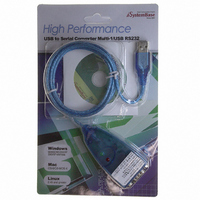20-151-0178 Rabbit Semiconductor, 20-151-0178 Datasheet - Page 78

20-151-0178
Manufacturer Part Number
20-151-0178
Description
CABLE CONVERTER RS-232 TO USB
Manufacturer
Rabbit Semiconductor
Datasheet
1.20-151-0178.pdf
(162 pages)
Specifications of 20-151-0178
Accessory Type
USB to RS232 Adapter
Product
Microcontroller Accessories
For Use With/related Products
Rabbit-based Boards
Lead Free Status / RoHS Status
Lead free / RoHS Compliant
Other names
20-151-0178
316-1181
316-1181
- Current page: 78 of 162
- Download datasheet (4Mb)
Note that the RabbitFLEX BL300F LCD driver is intended to support modules based on the Hitachi
HD44780 chipset, but we cannot guarantee compatibility will all LCD modules based on this chipset. To
ensure compatibility, use the LCD module that we provide for the RabbitFLEX BL300F.
After the display has been initialized, there are a number of functions to display text, manipulate the cur-
sor, change the contrast, turn the backlight on and off, etc. See the flexDisp*() functions for more
information.
6.3.8 Speaker
The loudspeaker option can be used with two drivers: the tone driver and the audio driver. The tone driver
is intended to play a repeated tone for a specific number of repeats (or indefinitely). The audio driver is
intended to play a single audio sample. Tone driver functions begin with flexTone, and audio driver func-
tions begin with flexAudio.
To begin using the tone or audio drivers, you must first activate them with flexToneActivate() or
flexAudioActivate(), respectively. When activated, the drivers will consume about 10-20% of
your CPU. Thus, after you have played a tone or sample, you may want to shutdown the driver(s) with
flexToneShutdown() or flexAudioShutdown().
See the speaker_tone.c and speaker_audio.c for examples on using these drivers.
6.3.9 Thermistor
This is a PowerCoreFLEX feature—please see the PowerCoreFLEX User’s Manual for information on
using the thermistor.
6.3.10 Serial Flash
This is a PowerCoreFLEX feature—please see the PowerCoreFLEX User’s Manual
using the serial flash
72
// Number of rows on the display
my_lcd.num_rows = 2;
// Starting address of each row (up to 4 rows)
my_lcd.row_addresses[0] = 0x80;
my_lcd.row_addresses[1] = 0xc0;
// Minimum duty cycle for contrast control
my_lcd.pwm_contrast_min = 0;
// Maximum duty cycle for contrast control
my_lcd.pwm_contrast_max = 1024;
// Default scaled value for contrast control (0-255)
my_lcd.def_contrast = 0;
.
www.rabbit.com
Applications Programming
f
or information on
Related parts for 20-151-0178
Image
Part Number
Description
Manufacturer
Datasheet
Request
R

Part Number:
Description:
Microcontroller Modules & Accessories Assy Download 1.27MM and 2MM Pitch Cbles
Manufacturer:
Rabbit Semiconductor

Part Number:
Description:
Trimmer Resistors - Multi Turn 20Kohms 5% 1 1/4 PC Mount
Manufacturer:
Bourns Inc.
Datasheet:
Part Number:
Description:
LCD Drivers 160 SEGMENT LCD SEGMENT DRIVER
Manufacturer:
NXP Semiconductors

Part Number:
Description:
20-24 awg TIN PIN REEL M-N-L
Manufacturer:
TE Connectivity
Datasheet:
Part Number:
Description:
IC REAL TIME CLK/CALENDAR 20SOIC
Manufacturer:
NXP Semiconductors
Datasheet:
Part Number:
Description:
IC REAL TIME CLK/CALENDAR 20SOIC
Manufacturer:
NXP Semiconductors
Datasheet:
Part Number:
Description:
IC RTC/CALENDAR TCXO QTZ 20SOIC
Manufacturer:
NXP Semiconductors
Datasheet:
Part Number:
Description:
Manufacturer:
ON Semiconductor
Datasheet:

Part Number:
Description:
20-OUTPUT LVTTL CLOCK DRIVER
Manufacturer:
AMCC (Applied Micro Circuits Corp)

Part Number:
Description:
20-OUTPUT LVTTL CLOCK DRIVER
Manufacturer:
AMCC (Applied Micro Circuits Corp)

Part Number:
Description:
20-OUTPUT CLOCK DRIVER
Manufacturer:
AMCC (Applied Micro Circuits Corp)












